Inside look: are Filament lamps so good?
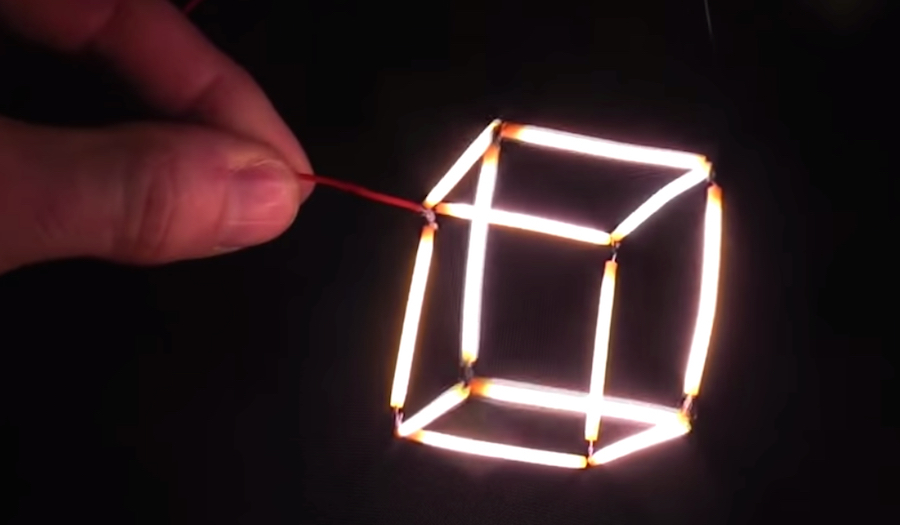
Welcome to LED lamp enthusiasts on the Prestigio blog pages!
Today we’ll talk about one burning and extremely popular topic recently, namely filament (or, in Russian, filamentous) LED lamps. A lot of articles have been devoted to them at Geektimes ( 1 , 2 , 3 ), but they do not affect the analysis of lamps and a comparison of their temperature characteristics. Therefore, especially for you, dear readers, we conducted a detailed analysis of lamps from different manufacturers, including temperature measurement of LED filaments. And under the cut we will try to answer the question, but it is good filament lamps, as they are
Background
When it comes to new technology, one of the most important questions immediately arises: how does this technology merge into the general technological “eco-environment”? Usually, revolutionary technologies simply do not fit into the usual course of things, and huge efforts have to be made to introduce revolutionary products. For example, this was the case with renewable energy sources installed on private houses, when the cost of the “kit” slipped by orders of magnitude , and in some places on our planet people are also paid extra for generating electricity, which required a revision of the relationship between producers and consumers of electricity. A completely similar story happened with electric cars, when the industry split up and went in two ways: hybrids and full-fledged electric cars with separate “gas station” stations.
About 5 years ago, LED lighting began to actively conquer its minions and adepts. Engineers for a long time tried to adapt two-dimensional by nature light sources for three-dimensional lighting (which only lamps in the form of corncobs cost ). This was written several times, both then and recently .
And now filament lamps were launched on the market. It would seem that a solution, even if not ideal, was found, when both “the sheep and the wolves are safe”: the bulb is practically no different from Ilyich’s bulb in both form and content, only the tungsten filament is replaced by an LED filament. Even the old glass-blowing factories and workshops found work . It is now proposed to use a ceramic translucent substrate to improve the radial distribution of the light flux of the lamps (for example, Crystal Ceramic MCOB ).
What is this mysterious filament? Briefly about the device thread
A filament is a pie made up of several components. A thin glass (does not conduct heat well) or a sapphire / ceramic (conducts heat well) substrate - depends on the greed of the manufacturer - with two contacts along the edges. LED chips are installed on this substrate, which are connected in series with the finest gold thread. Then the whole structure is filled with a phosphor and, voila, the filament is ready.

LED thread arrangement
The idea behind this type of LED is simple: an attempt to squeeze out a little more lm / W, because in this design it does not matter where the LED emits, unlike SMD. Anyway, the light will reach the phosphor and give a warm component (green and red).

LED thread arrangement
The idea behind this type of LED is simple: an attempt to squeeze out a little more lm / W, because in this design it does not matter where the LED emits, unlike SMD. Anyway, the light will reach the phosphor and give a warm component (green and red).
However, despite the undeniable advantages over SMD LEDs, filament lamps have a number of problems that for some reason they do not want to notice. For example, in the “standard” layout with SMD diodes, a rather massive aluminum substrate and housing effectively remove heat, while in threads the only way to remove heat is actually only convection and dissipation through the walls of the glass bulb. That is, banal overheating gradually kills both the diodes themselves (brightness drop with temperature) and the phosphor (CRI or R a color rendering index and CCT color temperature suffer ). Yes, this method of “overheating” works for a tungsten lamp, because the gas in it partially contributes to the regeneration of the filament during use, but no more. You can read more about overheating from a scientific point of viewhere . As follows from the presented article, temperatures of about 60-70 degrees can be considered relatively harmless.
In a nutshell, for an ordinary consumer, overheating or insufficient heat dissipation from LEDs means only one thing - a multiple (sometimes by orders of magnitude) deterioration in the characteristics of LED lamps

In order to confirm or refute this point of view, you need to stock up on lamps, take ordinary LED lamps for comparison and experiment ... including temperature measurements, which will help us with a Flir 5-series thermal imager with a 240 by 320 pixel matrix. Using this camera, the temperature was measured both on the flask for half an hour, and on the LEDs themselves after removing the flask.
By tradition, conclusions for those in a hurry are presented in two summary tables at the very end of the article . And lovers of a thorough showdown are welcome to the experimental part.
Experimental part
So, for the experiments, three lamps from different manufacturers were taken: a cheap Chinese lamp with Ebay from CroLED (actually, at a price equivalent to Eglo), another lamp from Eglo from the local Leroy Merlin and the respected and well-known Phillips. Yes, it is worth noting that perhaps the light bulb with Ebay does NOT have any relation to CroLED .
CroLED: Chinese quality ebay
Let's start with the filament lamp from the Middle Kingdom. The light bulb came from China in a simple cardboard box with a minimum of information on it (temperature, power and voltage. To be honest, the expectations were different, but the reality turned out to be much harsher. The ripple coefficient was 67% (!), I think this is a record ! In fact, the light went out and flashed again with a frequency of 10 ms. The color temperature differed in a smaller direction from what is indicated in the seller’s store on Ebay.

NB: All lamps presented in the article have a glass bulb. And although it can withstand falling to the floor, be careful when handling them!
Analysis of the bulb revealed one interesting design feature - namely, the driver. More precisely, its complete absence: the bulb is fed through a banal MB10F diode bridge with a pair of resistors and a huge solid-state capacitor. But compact!

LEDs are located on a matte (!) Substrate in the amount of 18 pieces. Each LED chip is made of a sapphire textured asterisk-like substrate . The chips are completely small - smaller than a human hair.
Why is it profitable for a manufacturer to make ultra-small LEDs?
Interest Ask. One reason is purely economic. Small LED chips simply do not require additional gold contacts to evenly distribute the electric field and, accordingly, uniform luminosity throughout the diode.
Another reason is the heat sink. It does not make sense to put a powerful large LED on a substrate that conducts heat relatively poorly.
Another reason is the heat sink. It does not make sense to put a powerful large LED on a substrate that conducts heat relatively poorly.
And what about the temperature? - the reader will ask. Yes, the temperature on the flask in about 5-7 minutes reaches about 40 degrees and remains so for half an hour.
But let's now look under the bulb of our lamp. After removing the glass and measuring the temperature, it turned out that the filaments very quickly (literally in 1 minute) heat up to almost 90 degrees, and in some places, apparently, where the LEDs are located, the temperature reaches more than 100 degrees.
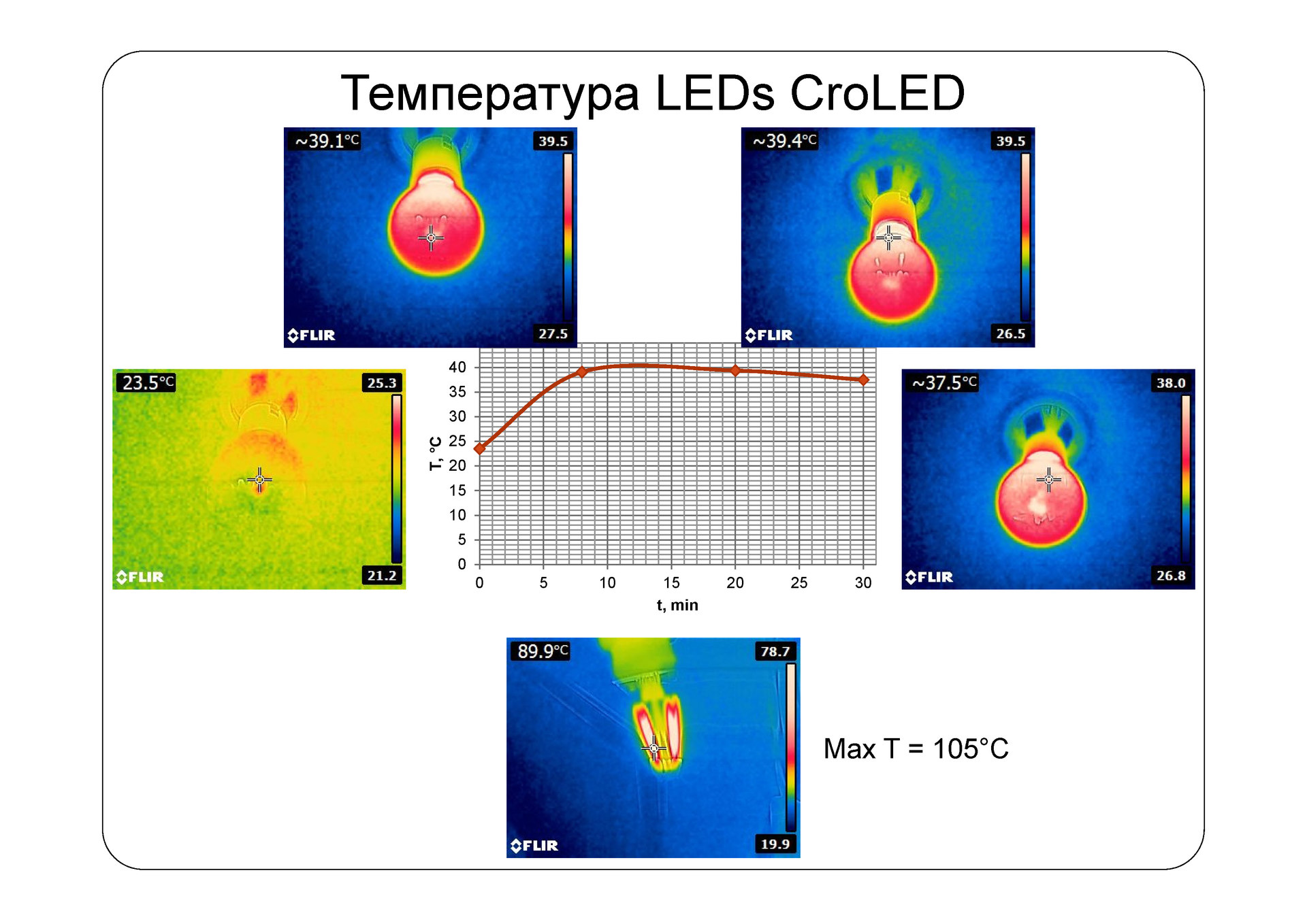
Eglo: conventional lamp with normal characteristics
The next lamp from the company Eglo, which, incidentally, has a representative office in the Russian Federation , in general, pleased with its characteristics. Ripples at a frequency of 100 Hz amounted to about 6%, while the color temperature and CRI are consistent with the declared characteristics.

Lyrical digression to the issue of flicker
For one of the articles on D3 , justicebest wrote the following:
Where it says:
Thus, flickering to a frequency of 300 Hz is still not desirable.
About 300 Hz it is said in GOST R 54945–2012 (1 Scope) and in SNiP 23–05–95 (clause 7.14). I also give a link to a medical study .
Where it says:
Note - The coefficient of ripple of light takes into account the ripple of the light flux up to 300 Hz. The pulsation of illumination above 300 Hz according to [1] does not affect the general and visual performance.
Thus, flickering to a frequency of 300 Hz is still not desirable.
Inside the lamp there are also four strands of LEDs, as in the Chinese lamp. Inside is hidden a capacitor-based ballast driver. LEDs are slightly larger - 113 by 57 microns than in the previous case. However, they are extremely poorly fixed on the again matte substrate.
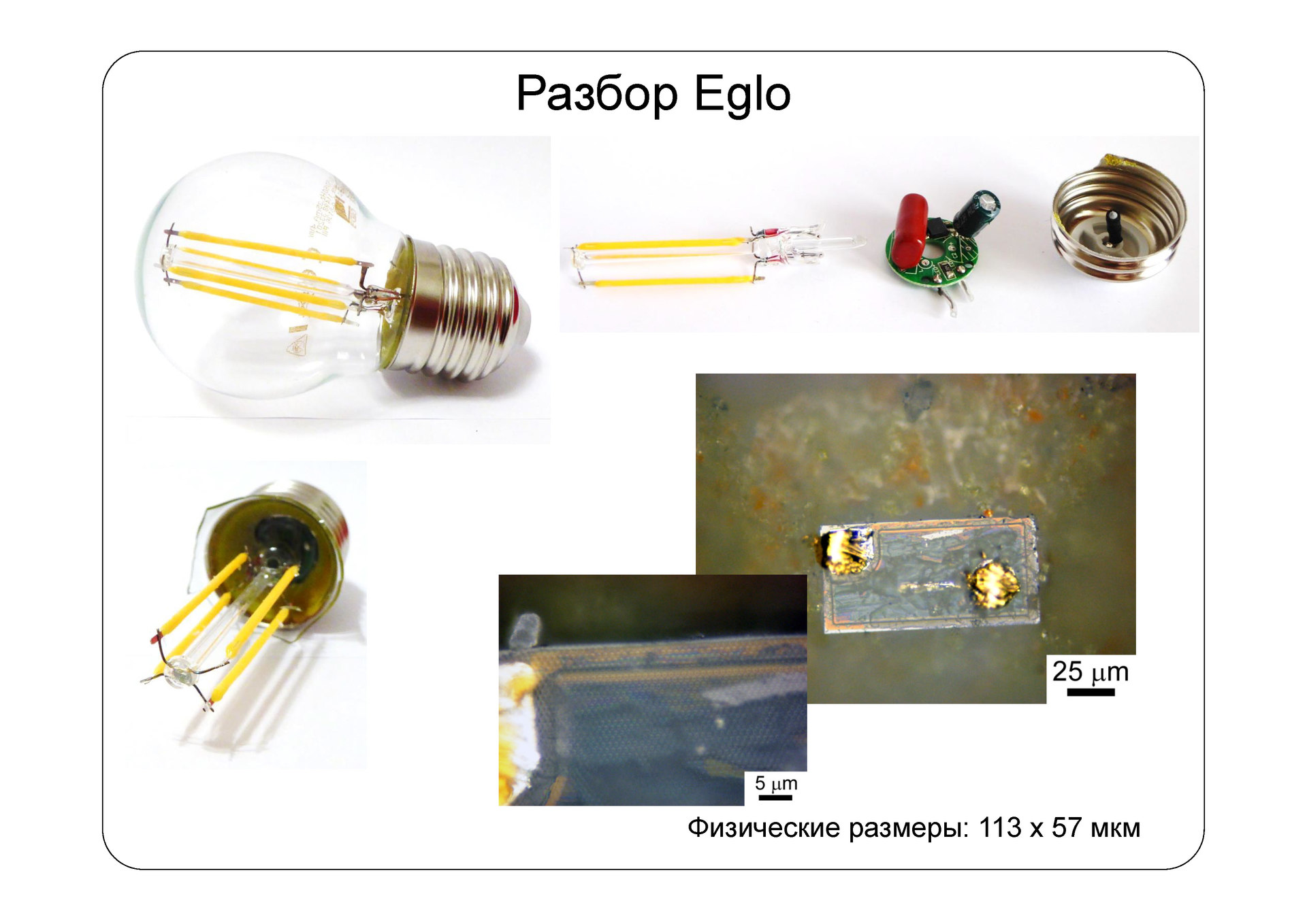
As for the temperature, the bulb quickly (in the same 5-7 minutes) heats up to a temperature of about 50 degrees. And the filaments again show a temperature of ~ 90 degrees. It’s just like a curse of a kind of incandescent lamp!
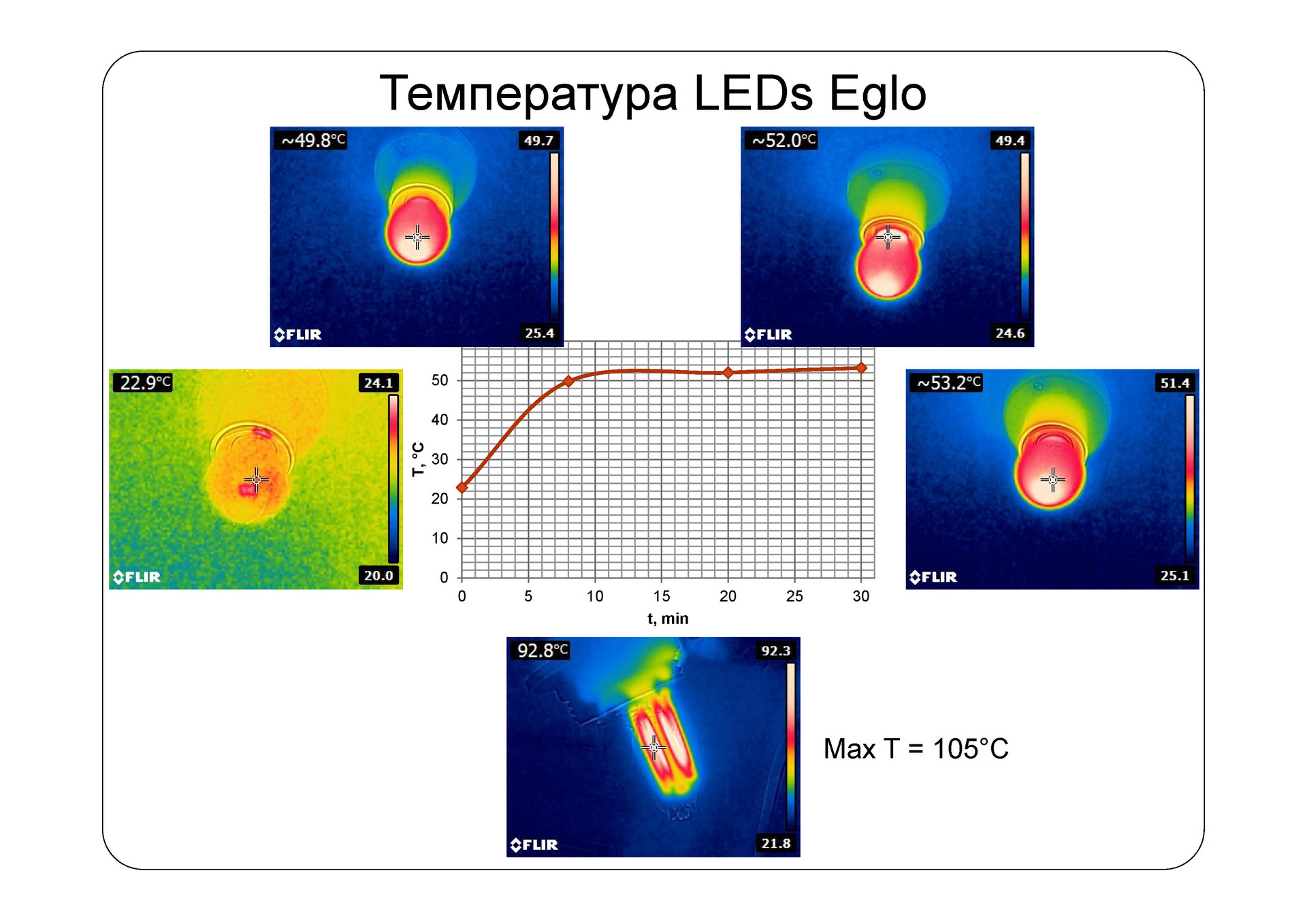
Phillips: Quality Above All
The last tested bulb manufactured by Phillips. Surprisingly, this bulb in the E14 housing shows excellent compliance with the declared characteristics and the level of ripple is extremely low.
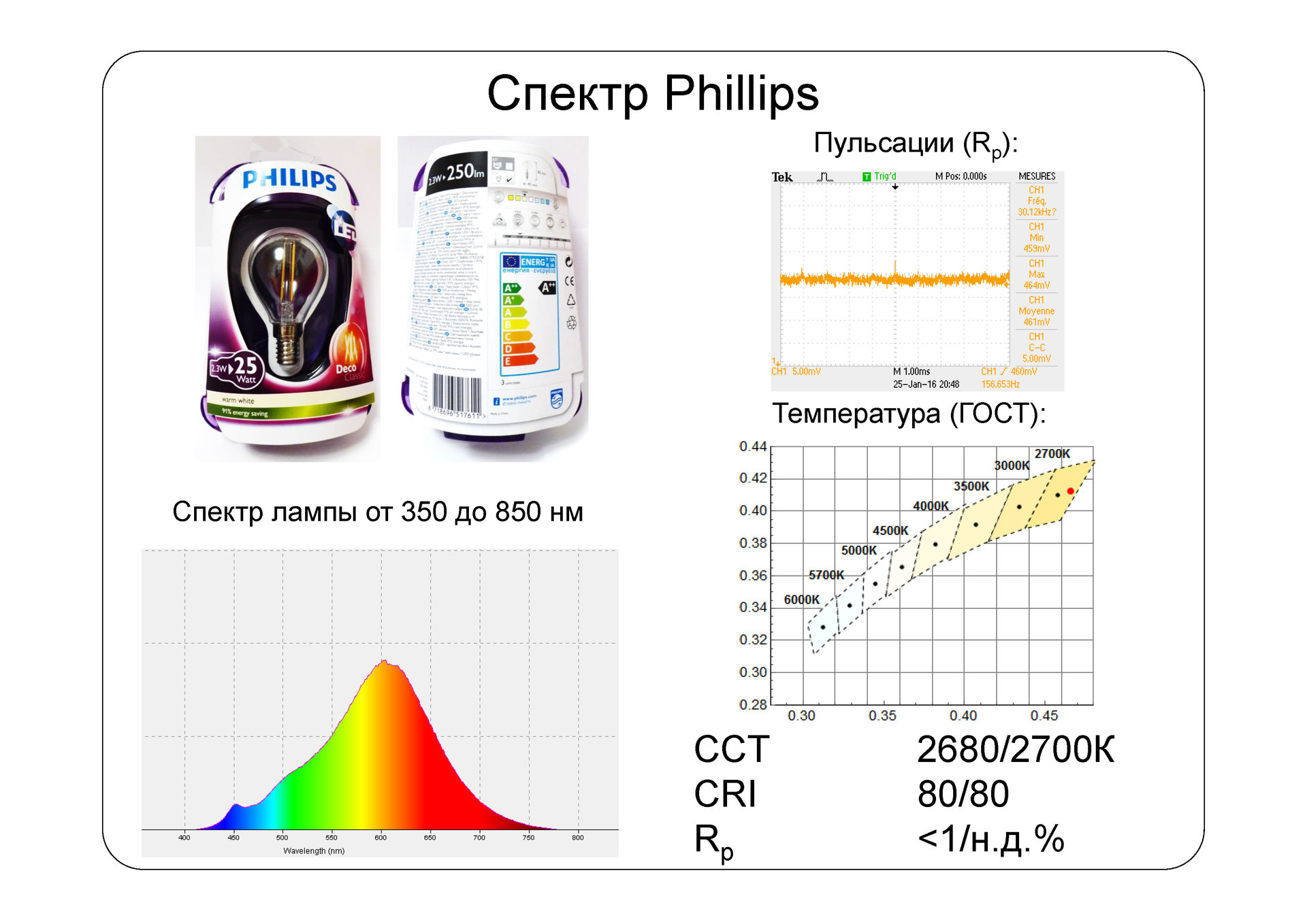
What is the reason for this, because the base E14 is much smaller than E27? - You ask a question. Everything ingenious is simple: Phillips has good, very good engineers who are able to create an ultra-compact driver (flyback converter) so that it fits in the E14 cartridge, while the driver provides an extremely low ripple level (<1%).
There are only two LED threads in the lamp itself, since it consumes only 2.3 watts. LED chips are placed on a transparent substrate and are similar in size to those used in Eglo lamps, but with a different substrate texture - “shield” . As already noted above, there is no arguing against the laws of thermal physics.
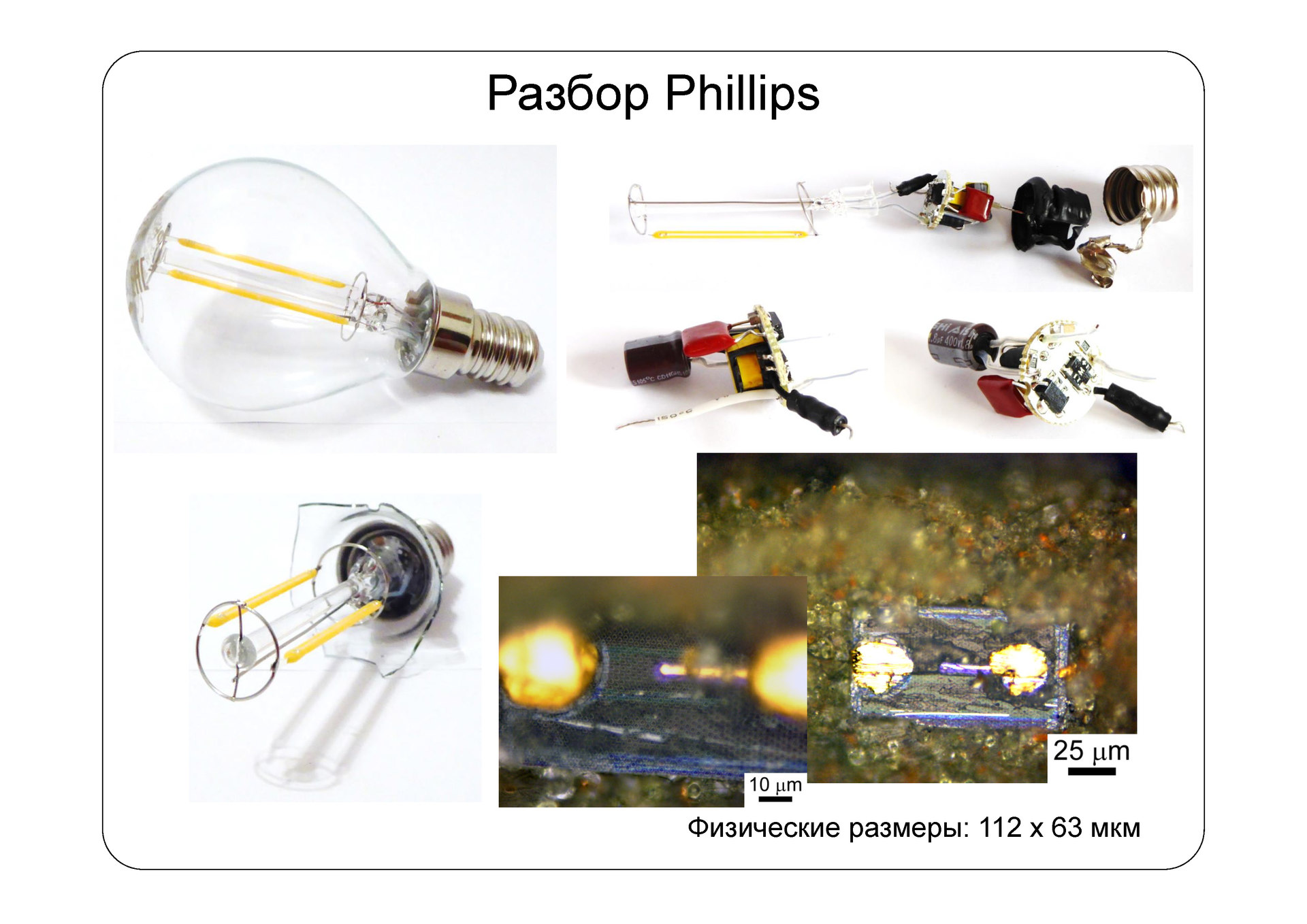
In about 10 minutes, the lamp bulb warms up to ~ 45 degrees (two strands “warm up” the entire lamp more slowly). However, the temperature of the strands without a glass bulb was still 95 degrees, in some places - we will repeat, most likely, in the place where the LED chips are attached to the substrate - reaching values of 110-120 degrees.
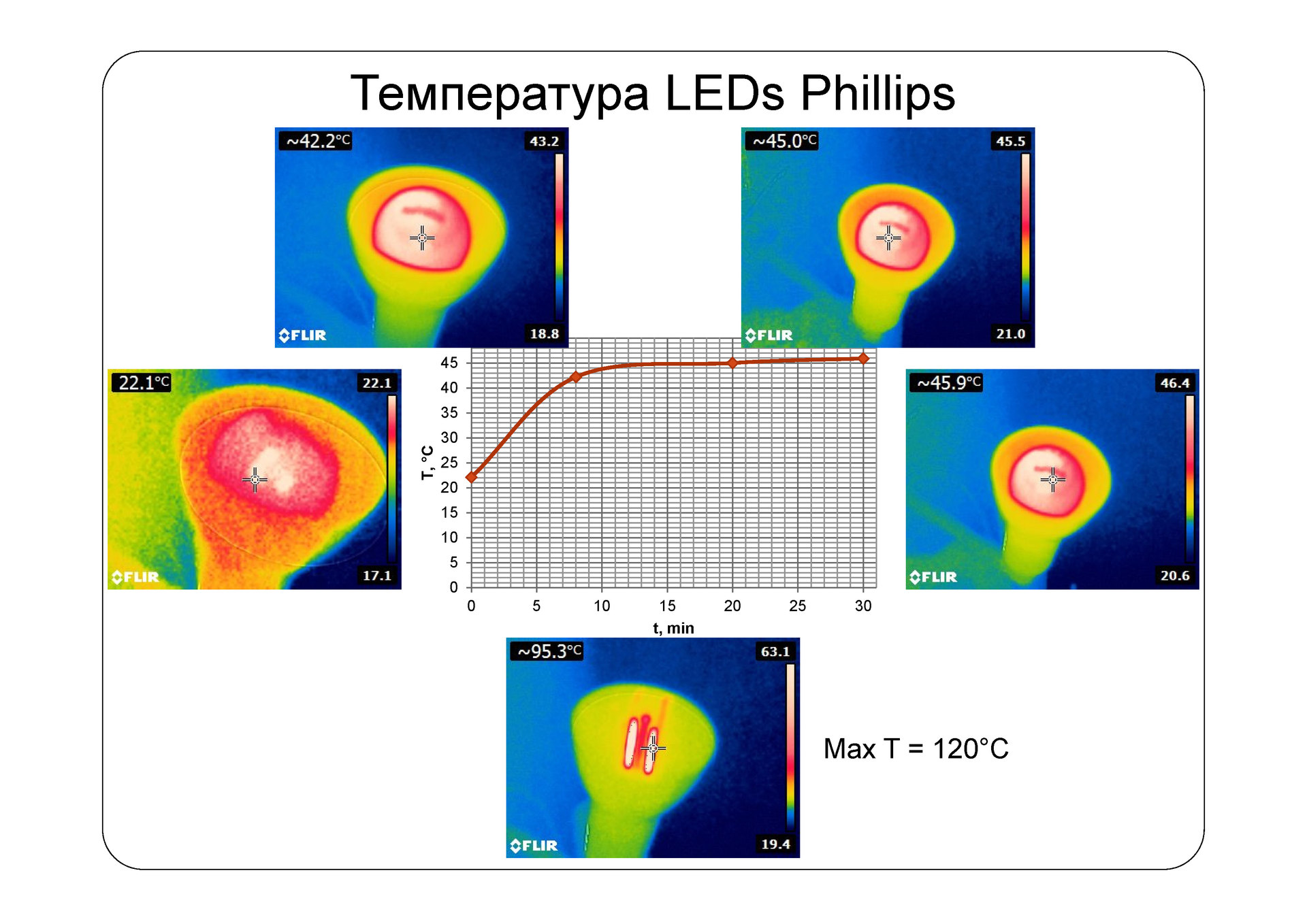
In order not to be unfounded when making a verdict regarding filament lamps, we will add a few photos of already familiar IKEA lamps and powerful smart Prestigio lamps, which we will talk about next time. The housing of the IKEA lamp warms up to 75 degrees in half an hour, and the smart Prestigio lamp up to 58. At the same time, the SMD LEDs of Prestigio lamps, for example, are heated at maximum power only to the “safe” temperature specified at the very beginning of the article, 60-70 degrees.
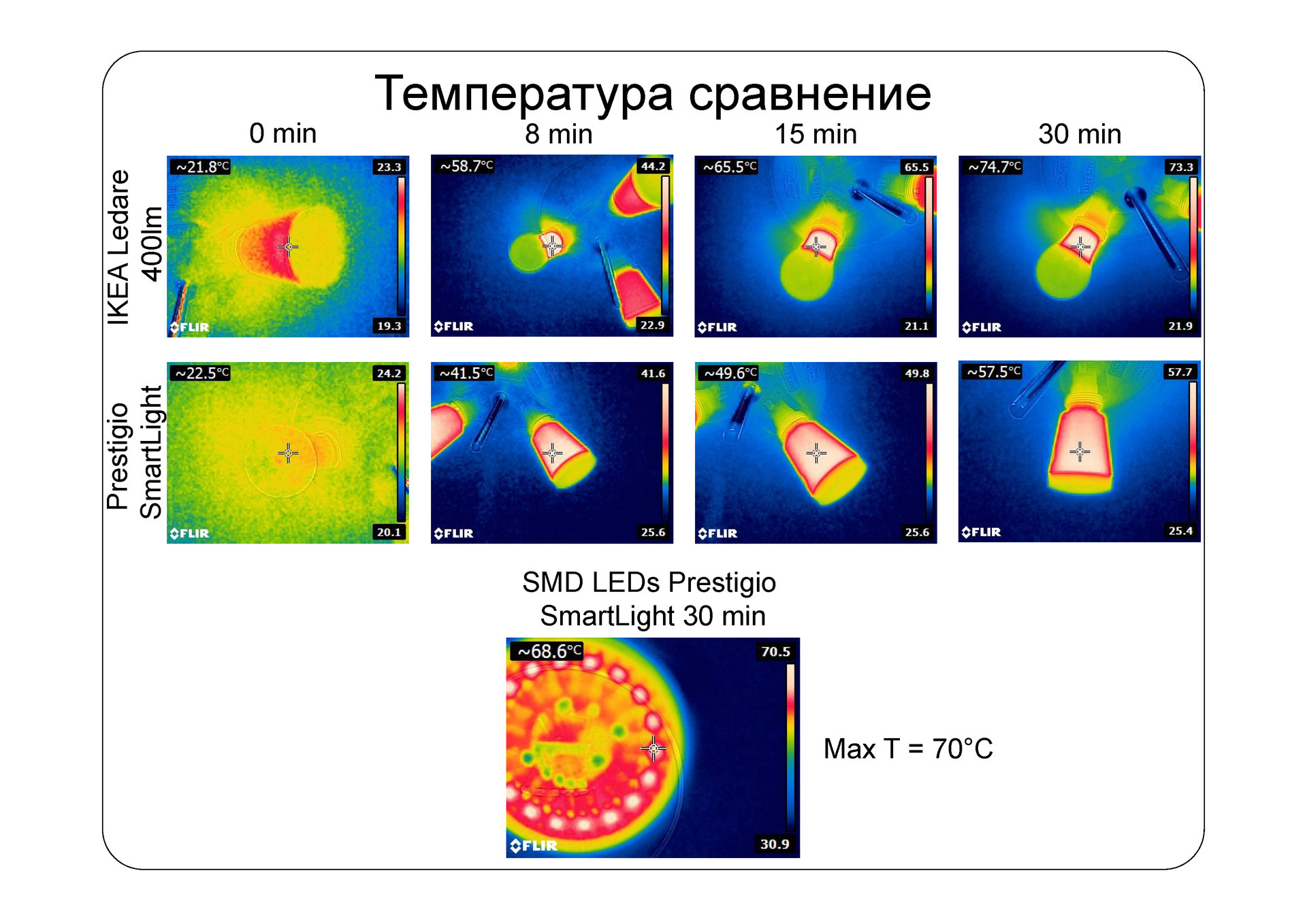
conclusions
Let us now to sum up the results and try to answer the question of whether the game is worth
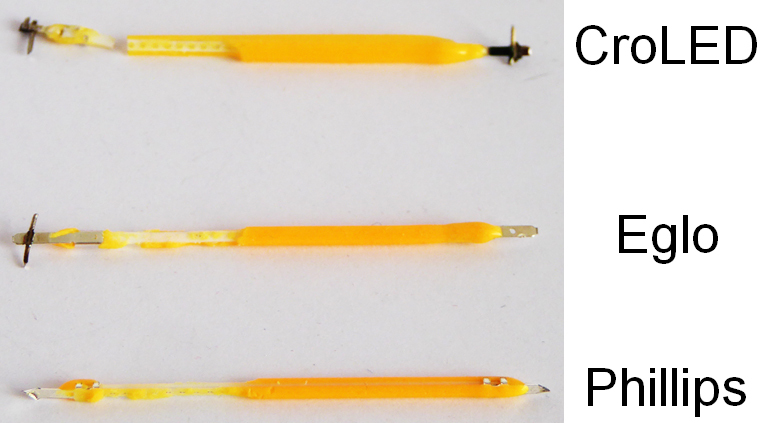
- By tradition, the test data obtained are summarized in the table below. But, in my opinion, you should not trust the claimed luminous flux of the Chinese lamp, and the rest of the characteristics do not inspire confidence. Do manufacturers of consumer goods have a habit to overestimate results. Otherwise, the Eglo and Phillips lamps correspond to those stated on the package, and China - you understand everything perfectly ...
Please save your health and time - request test results before buying LED lamps on Ebay, and in ordinary stores you will also have to enter this measure! - A comparison of the spectra did not reveal any significant differences: most of the lamps most likely use the same phosphor, which gives a warm tube filament light. There are slight variations of the blue component, which can be seen in the color temperature above: Eglo is the warmest, Phillips in the middle, CroLED “the coldest”.

- If we talk about some kind of technology, then only Phillips has the right to be called a good and safe lamp with a normal driver, once again confirming the status of a leading player in the market.
All tested lamps have surprisingly the same values of specific luminous flux and specific power. These values are comparable with the average performance of SMD lamps . Apparently, the heat transfer and heating of the LEDs significantly limit these characteristics in comparison with the usual layout based on SMD LED assemblies. - And the most delicious is in store for dessert. Measuring the temperature of the filaments themselves using an infrared camera (thermal imager) - we hope - convincingly shows and proves that filament technology cannot be a complete replacement for conventional SMD lamps with an aluminum radiator and a much more efficient heat sink. Plus we add a significantly limited space for the driver and as a result we get that it will be difficult to create bright and powerful luminaires with a long service life based on filament (already 12 W lamps are often equipped with a radiator ).
In the next article, we will continue to poke around in the lamps and look
PS: In a previous review and comparison of IKEA and Canyon lamps , kenbik suggested testing the lamps for electromagnetic interference using an FM radio. There was no old receiver, so the SBH-52 headset with an integrated FM receiver was used.
Report: Of the installed IKEA, Gauss and Presigio smart bulbs, only IKEA LED bulbs are noticeably buzzing. And that's all: that E27, that E14 and different in power. Gauss practically does not make noise, as does Prestigio (do not forget, nevertheless, modern devices have effective noise reduction).
Stay tuned and subscribe to our blog ! It’s not difficult for you - we are pleased!
A full list of published articles "Inside View" on Habré and GT:
Opening the Nvidia 8600M GT chip , a more detailed article is given here: Modern chips - inside view Inside
view: CD and HDD
Inside view: LED bulbs
Inside view: LED industry in Russia
Inside view : Flash memory and RAM
Inside view: the world around us
Inside view: LCD and E-Ink displays
Inside view: digital camera arrays
Inside view: Plastic Logic
Inside view: RFID and other marks
Inside view: graduate school in EPFL. Part 1
Inside Look: Graduate School at EPFL. Part 2
Inside view: the world around us - 2
Inside view: the world around us - 3
Inside view: the world around us - 4
Inside view: 13 LED lamps and a bottle of rum. Part 1
Inside view: 13 LED lamps and a bottle of rum. Part 2
Inside view: 13 LED lamps and a bottle of rum. Part 3
Inside Look: IKEA LED Strikes Back
Inside Look: Are Filament Lamps So Good?
and 3DNews:
Microview: a comparison of displays of modern smartphones
